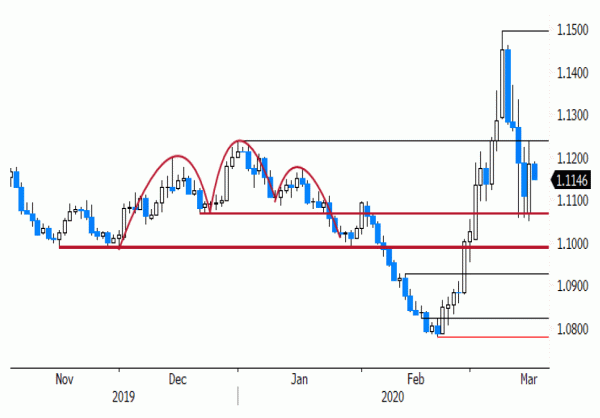- Rates: First signs of ST thaw, but waiting on coordinated fiscal response
Asian stock markets and core bonds show first signs of a short term thaw following the rapid escalation in measures to contain the spreading of the coronavirus. The (inefficient) monetary response is behind us, but fiscal initiatives remain ringfenced. It’s waiting for a coordinated fiscal response before we start becoming more neutral in general. - Currencies: None of the major currencies is able to claim the safe haven status
The dollar showed no clear trend after a modest setback in the wake of Fed policy action yesterday. None of the major currencies (euro, yen, US dollar) is currently able to convince investors of its safe haven capacity. The major fx cross rates are looking for a new reaction function. Will a credible fiscal response become the discriminatory factor?
The Sunrise Headlines
- WS suffered its worst one-day rout since Black Monday in 1987. The Dow Jones underperformed (-12.93%). The global sell-off eases in Asia as investors pin hopes on stimulus. Australia outperforms (5.83%).
- New Zealand pulled out all stops and announced a massive stimulus package of NZ$12bn, amounting to 4% of its GDP, to combat the coronacrisis. Brazil followed suit and announced a $30 bn injection into the economy.
- The US airline industry is stepping up calls for $50 bn in emergency aid as governments around the world are boosting efforts to help domestic airlines survive the shutdown of travel amid the widening coronacrisis.
- The Philippines shut its financial markets until further notice in response to the crippling impact of the coronacrisis, becoming the first country to do so. The country’s stock exchange chief said he plans to reopen the market on Thursday.
- The largest US banks are tapping the Fed’s discount window, a lending facility largely dominant since the financial crisis, to reactivate the window and encourage its use by smaller banks to weather short-term funding crunches.
- Eurozone finance ministers are looking to the ESM – the bloc’s bailout fund – to get the European economy through the coronavirus pandemic. The bailout fund is exploring ways to deploy its €410 bn in unused firepower.
- Today’s economic calendar contains February US retail sales and UK employment figures. All eyes will be on the March German ZEW indicator that may reflect the corona bearishness that’s been sweeping global markets
Currencies: None Of The Major Currencies Is Able To Claim The Safe Haven Status
None of FX majors able to claim safe haven status
Yesterday, unprecedent actions of the Fed (and other CBs) during the weekend/yesterday morning didn’t change the global trading in any profound way and this also applied to FX trading. Smaller, less liquid currencies mostly remained under heavy pressure. The dollar initially lost modest ground against the yen and the euro after the Fed policy decision. However, after the ‘initial’ repositioning, there was no clear directional trend. Trading in the likes of EUR/USD and USD/JPY remains kind of erratic in nature. None of those major currencies was able to indisputably take up the role of safe haven. USD/JPY closed at 105.83 (107.29 at the open). EUR/USD finished at 1.1183 (open at 1.1067).
Overnight, trading in Asian equity markets remains volatile, but the performance is not too bad, compared to the sell-off on WS yesterday evening. Investors are pondering multiple fiscal actions from governments (admittedly mostly still on a standalone basis) to mitigate the economic impact of the corona crisis. New Zealand is taking bold action (4% of GDP) but for now it doesn’t inspire the kiwi dollar much. The Chinese yuan is holding stable near USD/CNY 7.00. USD/JPY hovers in the mid 106 area, with no clear directional bias, even as the sell-off of risky assets slows. EUR/USD is holding a tight range in the 1.1170 area.
German ZEW confidence and US retail sales usually are potential market movers, but in the current environment they probably won’t bring any meaningful/reliable info on the future market or economic impact of the virus. Credible fiscal measures probably are key to put some floor for the current market sell-off. The FX market is also looking for a new reaction function. Among the major countries, no one currently delivered such a more credible solution. In this context, more technical trading among the majors (EUR/USD, USD/JPY) might be on the cards. If the sell-off of risky assets slows, hard hit smaller currencies with good fundamentals might stage ST technical rebounds. For EUR/USD, we assume more range trading in the 1.1050/1.1250 range. We are a bit more cautious on sustained USD gains.
Yesterday, the risk-off repositioning kept sterling under pressure. The UK apparently also lags other countries in taking decisive measures to contain the virus. It is unclear how much this weighs on sterling but it doesn’t help (risk of prolonged impact & bigger backlash). North of 0.91, EUR/GBP is moving into overbought territory, but for now we see little reason to expect a sustained sterling comeback.
EUR/USD: None of the majors able to claim the safe haven status.













